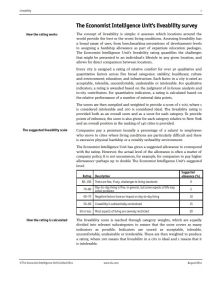Join getAbstract to access the summary!

Join getAbstract to access the summary!
Economist Intelligence Unit
The Economist Intelligence Unit's Liveability Survey
EIU, 2014
What's inside?
Financial crises and political conflicts leave their marks on the quality of life across the globe.
Recommendation
The 2014 edition of the Economist Intelligence Unit’s survey on livability offers a succinct yet granular assessment of living conditions in 140 of the world’s cities. The survey’s ratings derive from an elaborate construct of qualitative and quantitative metrics that gauge what makes a city livable: its “stability, health care, culture and environment, education, and infrastructure.” getAbstract commends this cogent reference to executives considering relocation, human resources professionals, business travelers and economic development specialists.
Summary
About the Author
The Economist Intelligence Unit is an independent research and analysis organization.





































Comment on this summary